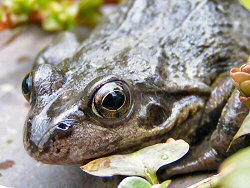With most of the leaves now down from the trees, it was time to uncover my pond; but I was in for a surprise as I did so.
My pond has been covered with a plastic net to keep falling leaves out of the water since the
end of September. At the weekend, seeing that nearly all the leaves from the surrounding trees had been shed (save for the Himalayan tree cotoneasters which always hang onto theirs for much longer), I decided to remove the net. When I did so I was saddened to find an adult frog (perhaps three or more years old) had become securely entangled in the fine mesh.
 Garden pond frog.
Garden pond frog.
This net was advertised for the purpose of covering ponds and it never occurred to me that it could represent a danger to any animals. It wasn't until after I had used it for a couple of years that I read in a leaflet called
Reptiles in your garden (published by
English Nature) that snakes are sometimes killed by fine-meshed flexible nets put over ponds or vegetable patches; but since here in Lancashire the likelihood of a snake visiting the garden is very low, I didn't deem it to be a problem.
The frog was so securely tangled up that I was sure that it was dead. However there was no sign of decomposition so I supposed that it had only just happened. Anyway, I went to the house to get some scissors to release the body. It even entered my head to cut the frog up to minimise damage to the net! Thank God I didn't do that because as I cut through each of the strands around the frog it started to move! By the time it was release it was quite active again. Quite how long it had been caught there I don't know. It is possible that since we hadn't had any severe frosts, it had remained caught there for some time in the torpid state that amphibians enter at this time of year. In any case, you can rest assured that if I use the same net next year, I will be checking it regularly for tangled animals.